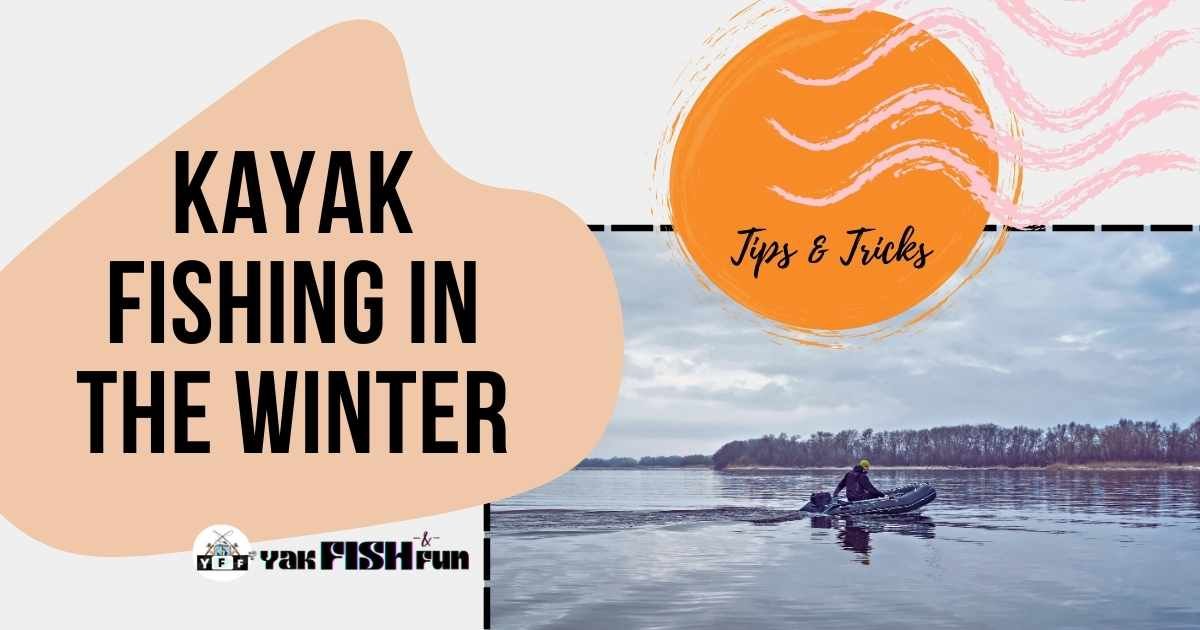Kayak fishing in the winter presents a unique and thrilling challenge for outdoor enthusiasts who seek to take their angling skills to the next level.
Apart from the breathtaking beauty, winter kayak fishing provides an opportunity to encounter wildlife in their natural habitat without disturbances from other anglers. Fish behavior changes during this season, presenting new challenges and techniques for successful angling.
Compared to the summer months, the colder months offer a unique thrill and reward for kayak anglers like yourself. However, adequate preparation is crucial to ensure maximum success and enjoyment during winter kayak fishing adventures.
This guide will explore the ins and outs of winter kayak fishing. And the reasons why one should embrace this challenging sport and provide essential tips for preparing effectively.
By the end of it, you’ll also discover how water temperature, wind patterns, and weather conditions impact your fishing experience.
Table of Contents

Why Go Kayak Fishing During Winter Months
Winter might not be the most popular time for outdoor activities, but it can be really exciting, especially for kayak fishing. There are good reasons for this:
First, there are fewer people on the water during winter, so it’s less crowded. Also, fish behave differently in the cold, which can be interesting for anglers.
If you’re looking for a new and challenging experience, winter kayak fishing is just that. It makes you test your skills and adapt to the changing weather. Learning how to fish in winter can be really satisfying and helps you become a better angler.
In the colder months, you explore new fishing spots you can’t visit in other seasons. Lakes and rivers that are packed with boats and swimmers in the summer are peaceful and quiet in the winter. This sense of adventure makes your kayak fishing trip more exciting. So, even though it’s cold, winter kayak fishing can be a great adventure for any angler to consider!
The thrills of winter kayak fishing
One of the exceptional thrills of winter kayak fishing is the opportunity to enjoy less crowded fishing spots. In the summer, many people go fishing, but in winter, it’s much quieter and more peaceful on the water. Being alone on the water can be really calming and nice for your mind.
Also, fish behave differently in the cold, which can help you catch more of them. When it’s cold, fish gather in certain spots and eat in different ways. This gives you a chance to try new fishing techniques and explore these colder waters.
And remember the beautiful winter scenery! Picture yourself paddling through shiny ice formations while all around you, trees are covered in snow. You might also see more wildlife that’s active in the colder months. It’s like a winter wonderland on the water! These sights create a picturesque backdrop that enhances your overall fishing journey.
How Does Winter Differ From Summer For kayak Fishing
Winter kayak fishing is quite different from summer fishing in several ways. One big difference is the water temperature—it’s much colder in winter. So, to stay warm and dry, anglers need to wear special gear like wetsuits or dry suits. These outfits keep them cozy and shielded from the cold water.
Moreover, fish behavior undergoes significant adjustments due to colder temperatures. They become less active and tend to move slower, requiring anglers to modify their bait and lure choices accordingly. Understanding these changes is crucial for maximizing your chances of success on the water.
Safety precautions also need special attention during winter kayak fishing. Cold weather conditions can pose risks, including hypothermia and strong winds. Therefore, checking weather forecasts, dressing in layers, carrying safety equipment like a personal flotation device (PFD), and informing someone about your fishing plans is essential.
Explore the rewarding experiences unique to winter kayak fishing.
Winter kayak fishing is truly special and different from any other time of the year. The water is super clear during winter so you can see well beneath the surface. This makes the whole experience amazing because you can see the underwater world and spot fish easily.
What’s even more satisfying is catching fish in the winter when many anglers stay home. It feels like a big achievement to face the cold and conquer the elements while others are indoors. The challenge of conquering the cold-weather elements while others stay indoors can make every catch feel even more triumphant.
Techniques for Catching Fish in Cold Water
Anglers need to adapt their techniques to the cold water conditions. The colder air temperature and potential immersion require careful preparation and adjustment of strategies.
Adapt your bait and lure choices for cold-water conditions.
Fish metabolism slows down in cold water, making them less active and more selective about their food choices. It is important to adapt your bait and lure choices to increase your chances of success. Opt for smaller baits that mimic the natural prey available during winter months. Consider using live bait, such as minnows or worms, as they are often more appealing to fish in colder temperatures. Choose lures with slower action or finesse presentations that entice sluggish fish.
Use slower presentation techniques to entice sluggish fish.
Slower presentation techniques are crucial when targeting fish in cold water. As mentioned earlier, fish become lethargic during winter months due to the drop in water temperature. Therefore, using slower retrieval rates can be highly effective in enticing these sluggish fish to bite. Try vertical jigging or deadsticking methods where you allow the bait or lure to sit still for extended periods before giving slight movements.
Understand changes in fish feeding patterns during winter months.
Fish feeding patterns undergo significant changes during the winter season. Understanding these variations can greatly improve your chances of success on the water. In the colder months, lots of fish like to go deeper in the water where it’s warmer or where there are things like rocks or plants to hide behind. They do this to find food more easily. So, when you’re fishing in winter, try to find these spots by looking at the underwater landscape or using electronic devices if you have them. This way, you can increase your chances of catching fish.
Adjust your strategy based on water clarity and temperature fluctuations.
During the winter, it’s important to think about how clear the water is and how warm or cold it is because these factors affect how fish act.
When the water is clear, fish can see really well, so they tend to be more careful. In this case, it’s best to use a gentle approach with a lighter fishing line and subtle bait. You don’t want to scare them away. On the other hand, if the water is murky and unclear, fish also can’t see. In murky water, you might need bigger lures or baits that are easy to spot and make noise to grab their attention. So, it’s all about adjusting your fishing strategy based on the water conditions to increase your chances of catching fish in the winter.
How To Prepare for Cold-Weather Kayak Fishing
Proper preparation is essential for a safe and enjoyable winter kayak fishing experience.
Dress Appropriately with Layers and Waterproof Gear
Layering is key. Wearing layers of clothing is a smart way to stay comfortable when the weather changes or your body temperature goes up and down. Begin with a base layer made of materials like merino wool or synthetic fabrics that can take moisture away from your skin. This helps you stay warm by preventing sweat from making you feel cold, even if the clothes get a bit wet.
Next, add insulating layers such as fleece or down jackets to trap heat close to your body. These layers provide an extra barrier against the cold air and help retain body heat. Finally, top it off with a waterproof outer shell that protects you from wind and water spray. A dry suit is an excellent option for ultimate protection against immersion in cold water.
Remember to protect your extremities! Wear gloves made specifically for cold weather to keep your hands warm while maintaining dexterity. A hat or beanie will help prevent heat loss through your head, and neck gaiters can shield your neck from chilling winds.
Check Weather Forecasts and Plan Accordingly for Safety
Before heading out on a cold-weather kayak fishing trip, always check the weather forecast. Sudden drops in temperature or strong winds can pose significant risks to the water. Pay attention to air temperature, wind speed, precipitation, and any potential changes throughout the day.
Related: Is Kayak Fishing Hard? What’s The Real Deal?
Plan your trip accordingly based on the forecasted conditions. If inclement weather is expected, consider rescheduling or choosing a more suitable location where safety won’t be compromised.
Pack Essential Safety Equipment, Including a Personal Flotation Device (PFD)
Safety should be your top priority when kayak fishing in any season, but it becomes even more critical in cold weather. Always wear a personal flotation device (PFD) designed for colder conditions. A PFD provides not only buoyancy but also insulation against the cold water.
In addition to a PFD, carry a whistle or signaling device to attract attention if needed. Pack a spare set of dry clothes in a waterproof dry bag in case of an unexpected capsize or immersion. Hypothermia is a real risk in cold water, so being prepared with proper safety equipment can make all the difference.
Insulate Your Kayak with Foam Padding or Insulation Kits
Consider insulating your kayak to enhance your comfort and safety while kayak fishing in cold weather. You can use foam padding or insulation kits to help trap heat inside the kayak and keep you away from the cold water.
Next, make sure your kayak is stable by adding safety gear like rod holders and places to store your stuff securely. It’s also a good idea to have floatation devices just in case your kayak flips over accidentally.
Following these tips will get you ready for cold-weather kayak fishing. Remember to dress warmly in layers and waterproof clothes, check the weather forecast before you go, pack important safety gear like a PFD (personal flotation device), and insulate your kayak for extra warmth. Stay safe and enjoy the thrill of winter fishing on the water!
Tips For Staying Warm and Comfortable On A Kayak Fishing Trip in Winter
Staying warm and comfortable on a kayak fishing trip in winter can be challenging, but with the right tips, you can enjoy your adventure even in cold weather. Here are some exceptional tips to keep you warm and cozy:
Layer your clothing
Layering is crucial to trap warm air close to your body. Start with a moisture-wicking base layer to keep sweat away from your skin. This will prevent moisture from cooling down against your body and causing discomfort. Add insulating layers such as fleece or wool over the base layer, which will provide additional warmth. Finally, top it off with a waterproof and windproof outer layer that will shield you from the elements.
Wear a wetsuit or dry suit.
A wetsuit keeps you warm by trapping a little bit of water between your body and the suit. Your body heat warms up this water, making you feel warm even if the suit gets wet.
A dry suit is different. It keeps you completely dry, even if you accidentally fall into cold water. So, both options help you stay warm and dry while you’re out in the cold.
Protect your extremities
Your hands and feet can get really cold because they have less natural warmth. To keep them warm and still be able to handle your fishing gear, you should get good neoprene gloves and socks. Neoprene helps keep them warm and flexible in the cold.
Remember your head and neck.
Heat can escape from your head and neck, so it’s important to cover them up properly. Wear a hat, beanie, or balaclava made of insulating material to keep these areas protected from the cold air. Consider wearing a neck gaiter or scarf that can provide additional warmth while preventing drafts.
Utilize hot packs
Pack some disposable hand warmers or body warmers in your pockets or inside your clothing layers. These small heat packs can provide targeted warmth to keep you comfortable for several hours. Please place them in areas where you tend to feel the cold the most, such as pockets, gloves, or boots.
Bring a thermos with hot liquids.
Drinking warm beverages can help warm you up from the inside when it’s cold outside. So, bring a thermos filled with your favorite hot drink like tea or hot chocolate. Sipping on these warm drinks keeps you warm and makes you feel happier during the cold weather.
Stay dry
While getting wet is inevitable while kayaking, there are steps you can take to minimize moisture contact. Use a spray skirt or splash deck to keep water out of the kayak and reduce exposure to splashes. Bring a waterproof bag to keep spare clothes and supplies dry in case of emergencies.
By following these tips, you’ll be all set for a winter kayak fishing trip that keeps you cozy and comfy during your adventure. Remember to prioritize safety and stay updated on the weather before you go out on the water.
Bottom Line
So, if you’re considering kayak fishing during winter, go for it! Don’t let the colder temperatures deter you from enjoying this thrilling adventure. As we’ve discussed in this blog post, there are plenty of reasons why winter kayak fishing can be just as rewarding as any other season.
You can have a successful and enjoyable fishing trip even in cold water by using the right techniques and preparing adequately. Remember to dress appropriately, stay warm and comfortable, and make safety a priority. With these tips in mind, you’ll be ready to tackle the challenges of winter kayak fishing head-on.
Now that you’re equipped with all the information you need to embark on your winter kayak fishing journey, what are you waiting for? Grab your gear and hit the water! The tranquility of nature combined with the excitement of reeling in a catch is an experience like no other. So get out there and create unforgettable memories while enjoying your favorite hobby!


